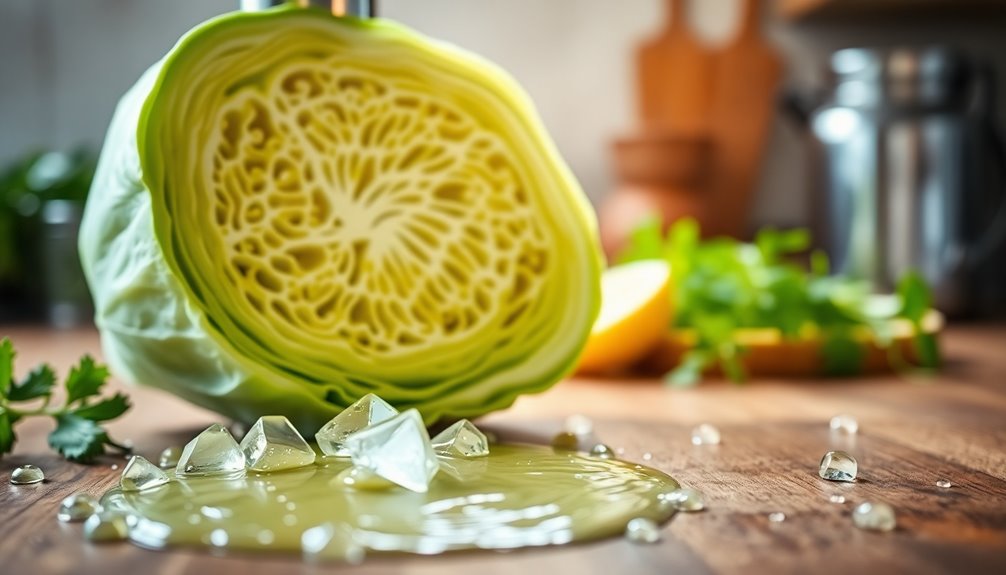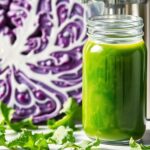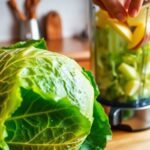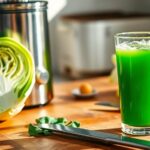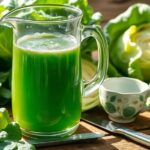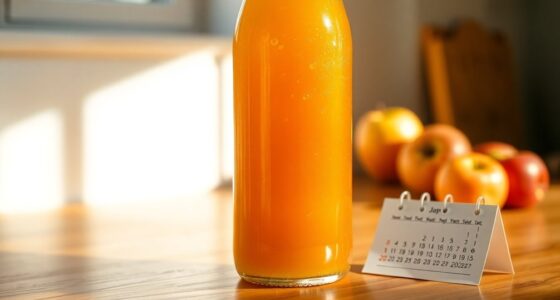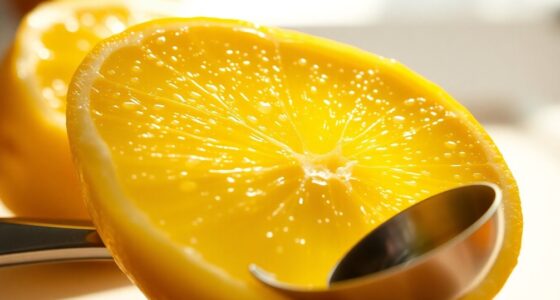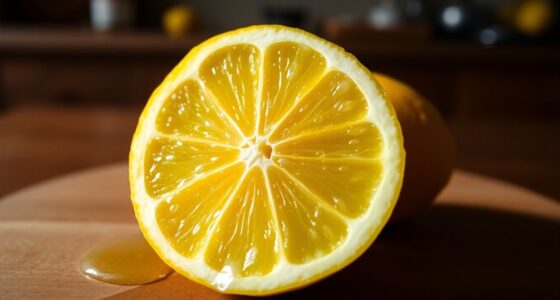To juice a cabbage, rinse it well and chop it into 1-inch chunks. Blend with a splash of filtered water until smooth. Strain the mixture using a fine mesh strainer or nut milk bag to separate the juice from the pulp. Enjoy the fresh juice immediately, or store it in an airtight container in the fridge for up to three days. Want to enhance the flavor or learn about fermentation? More tips are ahead!
Key Takeaways
- Rinse the cabbage thoroughly and chop it into 1-inch chunks for easier processing.
- Blend the cabbage chunks with a dash of filtered water until a liquid consistency is achieved.
- Use a fine mesh strainer or nut milk bag to separate the juice from the pulp.
- Store the cabbage juice in an airtight container and refrigerate for 1-3 days for freshness.
- Enhance the flavor by adding fruits like apple or lemon, or other ingredients like ginger or cucumber.
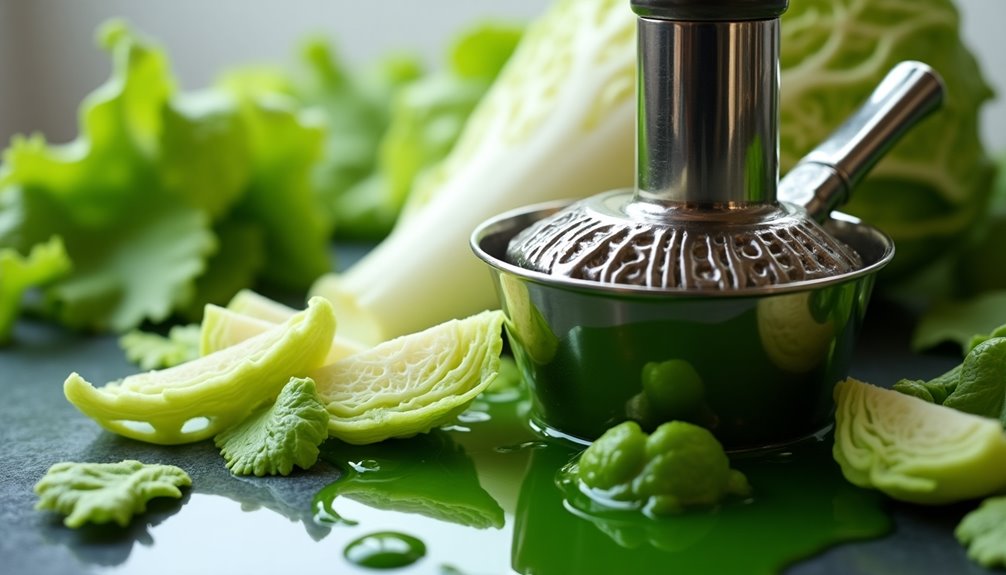
Juicing a cabbage might seem unconventional, but it's a fresh way to boost your health. Cabbage juice is packed with nutrients and can be a great addition to your diet. To get started, you'll need a head of cabbage and a few other ingredients to enhance the flavor. Rinse the cabbage thoroughly to remove any dirt or pesticides, then chop it into 1-inch chunks. This makes it easier for your blender or juicer to process.
If you're using a blender, toss the chopped cabbage into the container and add a small dash of filtered water. This tiny bit of water helps the blades move smoothly and ensures you get a nice, creamy juice. Blend the cabbage for about 1-2 minutes until it's well combined and reaches a liquid consistency. You'll want to make sure there are no solid pieces left in the mixture.
Next, it's time to separate the juice from the pulp. For this step, grab a fine mesh strainer or a nut milk bag. Place the strainer over a bowl or pitcher and pour the blended cabbage mixture into it. Use a spoon to press down on the mixture, helping the juice flow through while leaving the solid pieces behind. You can compost the pulp or discard it, but remember that you're left with nothing but pure, nutritious cabbage juice.
Fresh cabbage juice should ideally be consumed immediately to reap the maximum health benefits. However, if you need to store it, transfer the juice into an airtight container and pop it in the refrigerator. It'll stay fresh for 1-3 days, but keep in mind that the longer it sits, the more it may lose its nutrients.
To make your cabbage juice even tastier, don't hesitate to add sweetness. Ingredients like apple, lemon, ginger, or cucumber can elevate the flavor profile significantly. For instance, an apple adds a delightful sweetness that pairs well with the cabbage's natural earthiness. A squeeze of lemon juice not only brightens the flavor but also adds a dose of vitamin C, enhancing the juice's overall health benefits.
You might also consider experimenting with fermentation. By letting your cabbage juice sit at room temperature for a few hours, you can encourage beneficial bacteria to develop, turning your juice into a probiotic-rich drink. Just be sure to monitor the fermentation process closely; you want to enjoy the health benefits without letting it go too far.
Frequently Asked Questions
Can Cabbage Be Juiced?
Yes, you can juice cabbage! It's packed with nutrients like vitamins K, A, and C, along with fiber and minerals.
Juicing cabbage can boost your health, especially when combined with other fruits and veggies for flavor. You'll want to drink it fresh for the best benefits, as it's known to help with digestive health and even ulcers.
How Do You Juice Cabbage Without a Juicer?
You can juice cabbage without a juicer by starting with fresh, firm cabbage.
Chop it into small pieces and blend it with a little filtered water for 1-2 minutes until smooth.
Then, strain the mixture through a fine mesh bag or nut milk bag, squeezing out as much liquid as possible.
If you want, add fruits like apples or carrots for extra flavor.
Drink it fresh for the best health benefits!
How Do You Extract Cabbage Juice?
To extract cabbage juice, you'll first want to rinse and chop the cabbage into 1-inch pieces.
If you're using a blender, blend the chopped cabbage with a bit of water until smooth.
Then, strain the mixture using a fine mesh sieve or bag to separate the juice from the pulp.
For the freshest taste, drink it immediately or store it in an airtight container in the fridge for up to three days.
How Do You Clean Cabbage Before Juicing?
Did you know that about 90% of the nutrients in cabbage are found in the leaves?
To clean cabbage before juicing, start by removing any wilted or damaged outer leaves. Rinse the cabbage thoroughly under cold water to eliminate dirt and pesticides.
Then, cut it into quarters, remove the core, and chop it into 1-inch pieces. For added safety, soak the chopped cabbage in a vinegar-water solution for 5-10 minutes before rinsing again.
Conclusion
Juicing a cabbage might seem odd, but it's a refreshing way to pack in nutrients. You've transformed a humble vegetable into a vibrant drink that can boost your health. So, as you sip your cabbage juice, think of it as a green elixir, revitalizing your body from the inside out. Don't shy away from experimenting with flavors—mix in some apple or ginger for a delicious twist. Cheers to your newfound juicing adventure!
Cindy thoroughly researches juicing trends, techniques, and recipes to provide readers with practical advice and inspiration. Her writing style is accessible, engaging, and designed to make complex concepts easy to understand. Cindy’s dedication to promoting the advantages of juicing shines through her work, empowering readers to make positive changes in their lives through the simple act of juicing.

